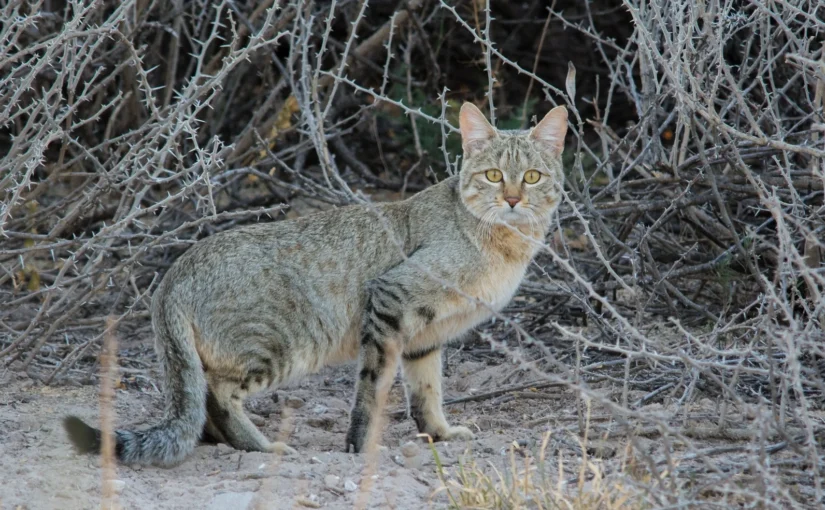At first glance, the African wildcat does not look particularly unusual. Its body is slim, its coat sandy brown streaked with faint stripes, its tail thick and ringed with darker bands ending in a black tip. For anyone used to watching housecats slip among alleyways or curl on windowsills, this little feline seems uncannily familiar. And so it should. The African wildcat, Felis silvestris lybica, is now widely accepted as the ancestor of the domestic cat. Thousands of years ago, when the first farmers in the fertile crescent stored their grain and inadvertently attracted rodents, it was these wildcats that moved in to hunt the pests. In return, they received protection and food. Over generations, as people grew accustomed to their presence and kittens adapted to life around settlements, the bond that gave us Felis catus was forged. When you look into the yellow eyes of your pet cat, you are gazing into a history that began with this modest creature.
The species was first described scientifically in 1777 by the German naturalist Johann Forster. Since then, it has been recognized as a subspecies of the wider group of wildcats that also includes the European wildcat. But while its European relative thrives in woodlands and cooler climates with a thicker coat, the African wildcat has adapted to harsher, warmer environments. Its fur is shorter, helping it stay cool beneath the African sun. Its coloration is practical desert camouflage: sandy grays and browns, streaked legs, and faint bands across the body. The face carries distinctive dark lines that frame the eyes and connect to the nose. Some scholars even suggest that these markings may have inspired the eye makeup used by ancient Egyptians to emphasize their gaze.
The eyes themselves are striking. Unlike domestic cats, which can sometimes have bright green eyes, the African wildcat’s gaze is invariably yellow, a molten gold that seems to glow in low light.
In size, this wildcat is a little larger and tougher than most domestic cats. From head to base of tail it measures between 50 and 75 centimeters, the tail adds up to 38 centimeters more, and body weight ranges from 3 to 6.5 kilograms. Males consistently outweigh females, though both remain agile and strongly built. Their lean muscles, long legs, and dexterous paws allow them to move effortlessly through high grass and rocky terrain in pursuit of prey.
The African wildcat lives across almost the entire continent, avoiding only the densest equatorial forests and the harshest deserts. In East Africa it prefers bushland and tall grasses, while in southern African regions it gravitates toward reed beds and marshes. It is especially common in hilly or mountainous terrain, but its adaptability is impressive. These cats thrive wherever cover is plentiful and small animals abound.
Their diet is varied, built around rodents, hares, and small birds, but extending to snakes, lizards, and insects. They are fast, decisive hunters, capable of quick bursts of speed and rapid pounces. Watching one stalk through the grass is to see the familiar movements of the housecat on the grand stage of the savanna. The same crouch, the same twitch of tail, the same sudden spring.
Reproduction follows a rhythm common to most wildcats. After mating, the female carries her young for 56 to 69 days before giving birth in a concealed spot, often a burrow or an underground den. Litters are small, rarely more than two or three kittens. For five to six months the young remain with the mother, learning the skills that will allow them to live independently. After about a year, females are capable of reproducing themselves. The males play no role in parenting. Since females may mate with more than one partner during a breeding period, paternity is often impossible to determine.
The African wildcat is solitary by nature, avoiding fellow cats outside the breeding season. Like most felines it is primarily nocturnal, prowling the night for prey and retreating to cover by day. Encounters with people are avoided whenever possible, and this wariness has shielded the species from some of the difficulties faced by more conspicuous wildlife.
Still, the African wildcat has grown rare in many regions. Habitat loss, hunting, and hybridization with domestic cats all impact the population. Hybridization is perhaps the most insidious threat, since it blurs the genetic line of the original wild form. As domestic cats breed with wild individuals, the distinct traits of lybica become diluted. Conservationists worry that in time it may become difficult to distinguish pure wildcats from hybrids.
Yet despite these challenges, many wild places in Africa still echo with the presence of this remarkable cat. For the casual observer it may pass unnoticed, blending so well with its surroundings that the eye slides over it as if it were a shadow in the grass. But for those who know to look, the African wildcat is a quiet marvel. It is wildness embodied in humble form, a reminder that even the commonest movements of the pet on your sofa trace back to a fierce, solitary hunter of African nights.
The African wildcat is at once familiar and exotic. It behaves like a pet cat, yet it remains untamable. It has ancient ties to human history, yet it still pads in solitude across savanna and hillside. In its yellow eyes burns both the past and the present: a legacy of domestication and a living spirit of the wild. To appreciate this little cat is to appreciate the depth of our shared history, and to recognize just how much of the wilderness still flickers in the companions that curl, purring, by our side.
Image by Leonemanuel.
If you find joy in these tales of twitching whiskers and gleaming eyes, consider helping keep Whiskerito.com alive and purring. Your donation supports thoughtful research, engaging content, and the warm, wonder-filled community that makes this space what it is.
